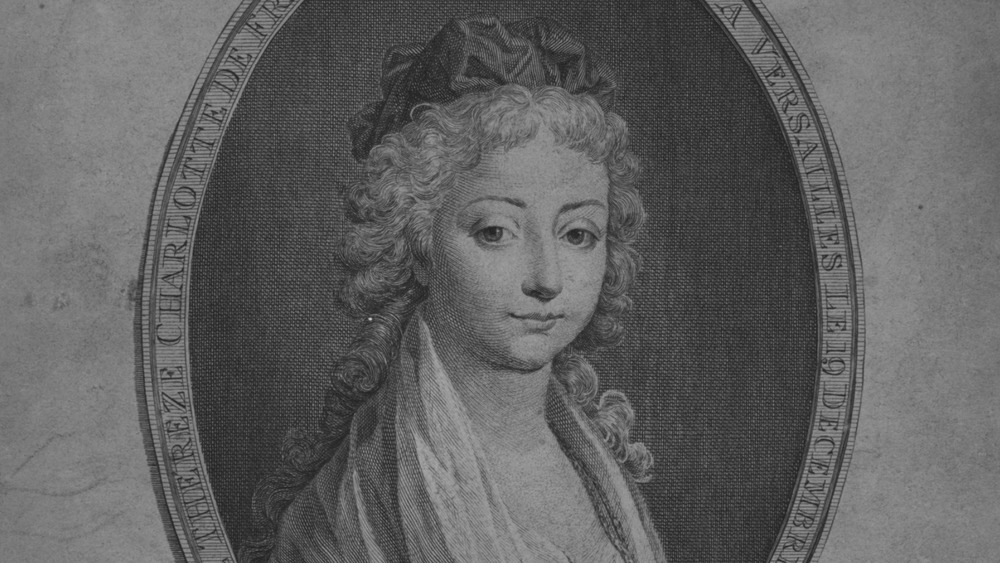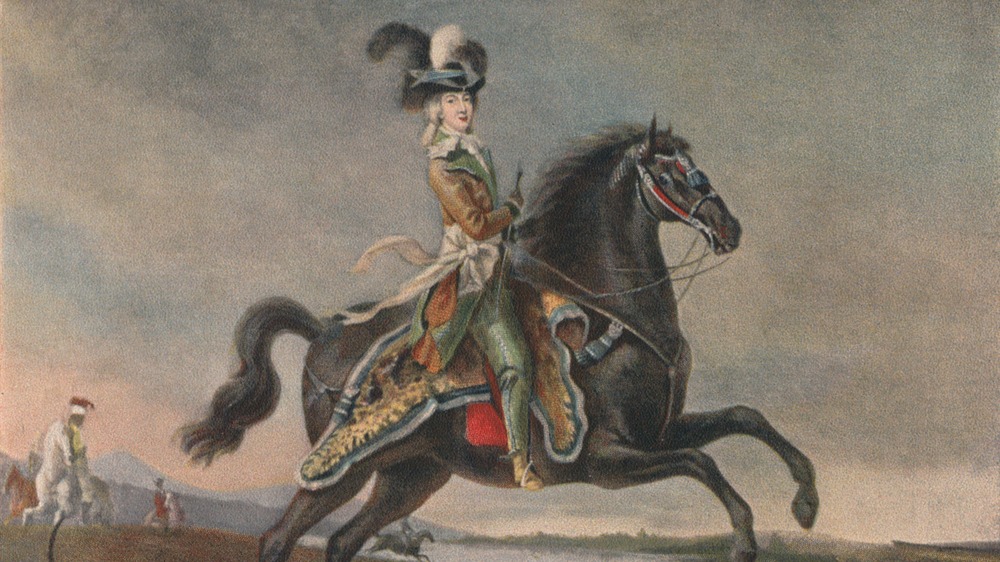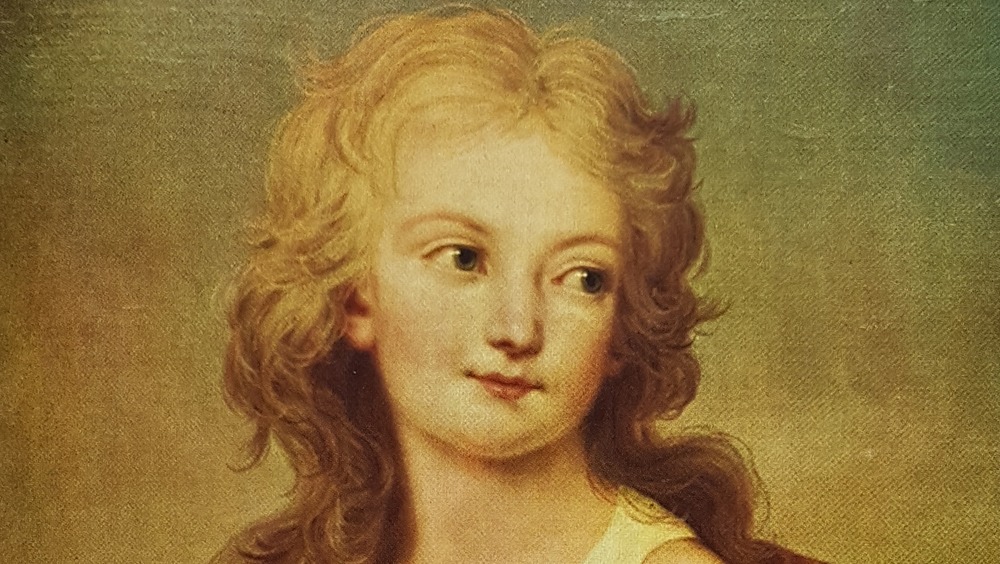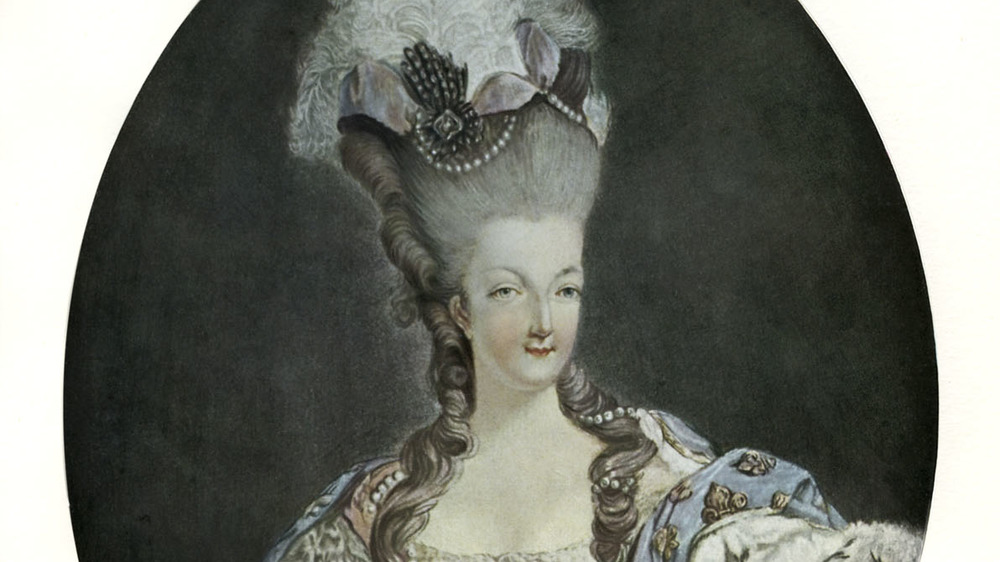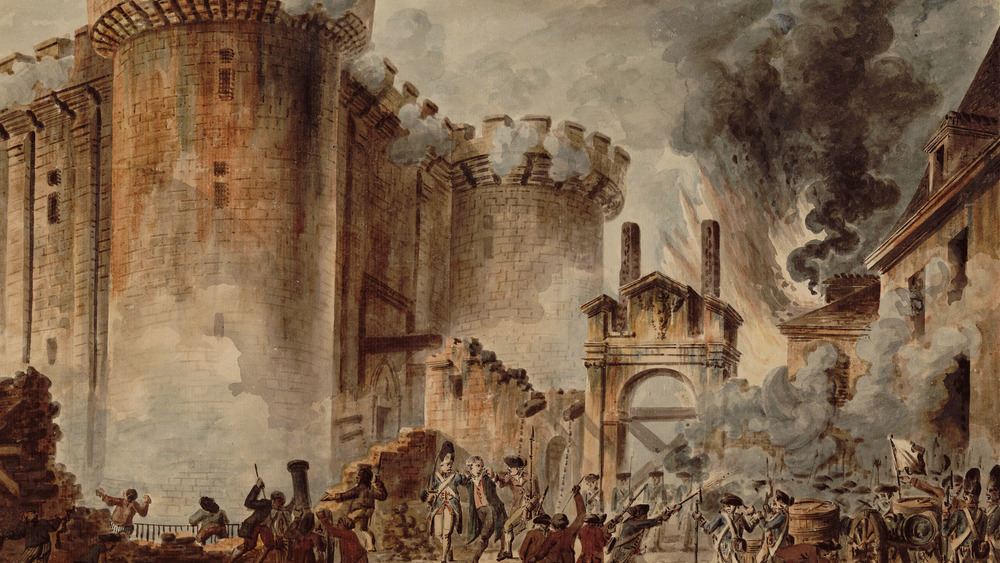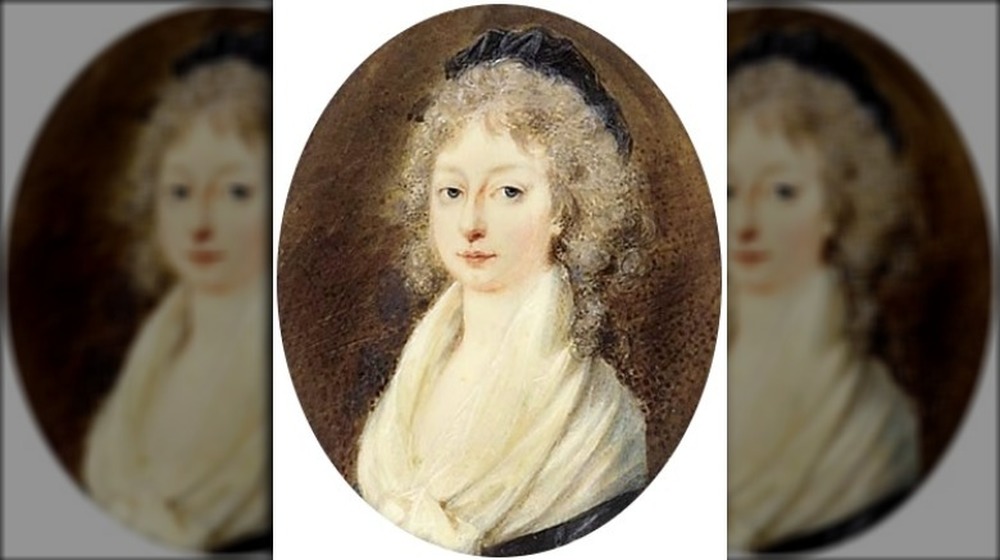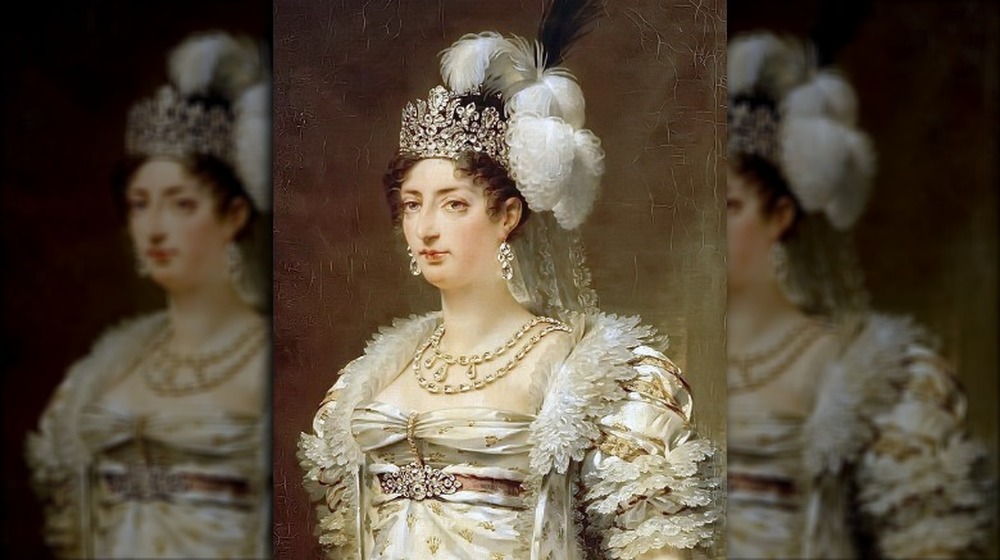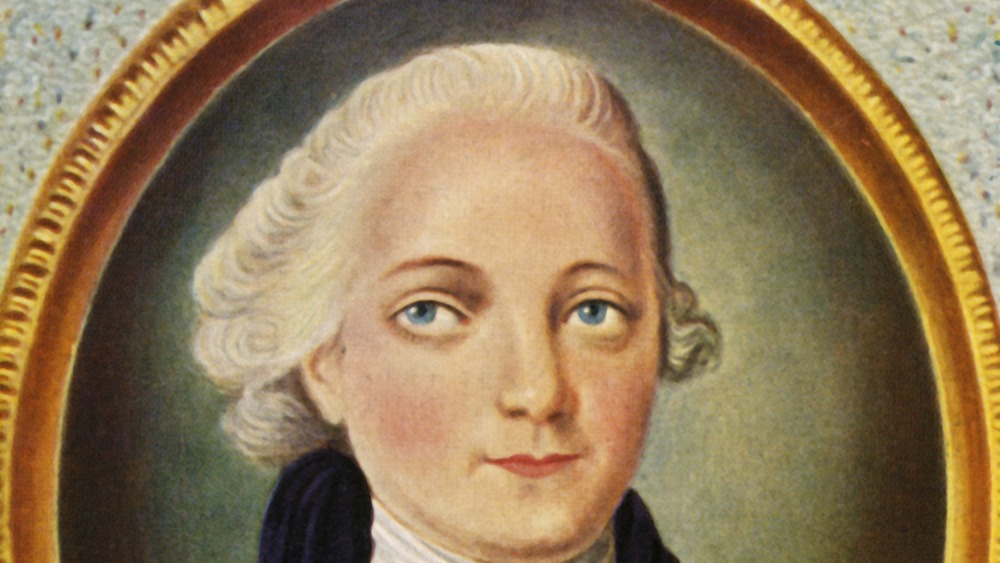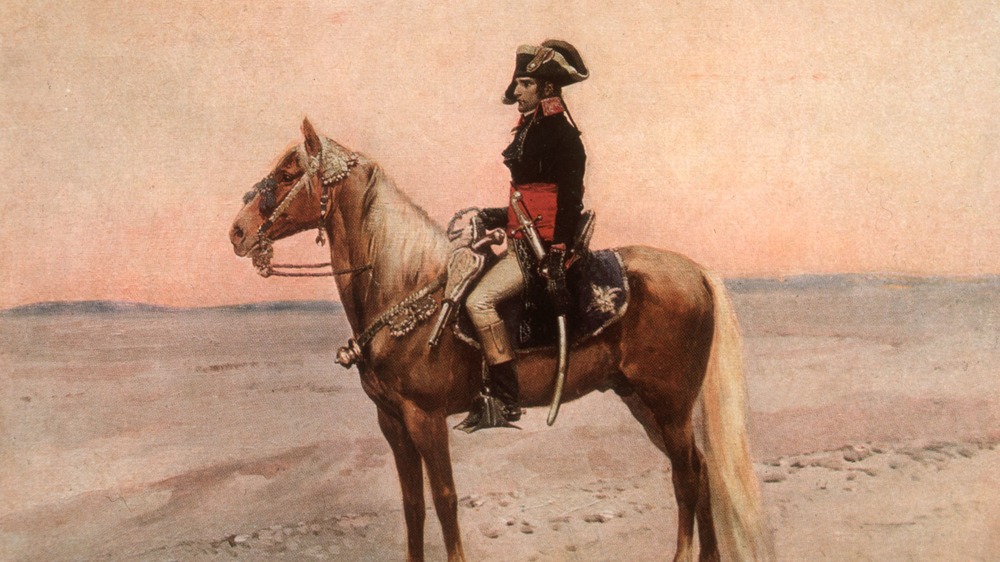The Tragic Real-Life Story Of Marie Therese Of France
Revolutions are generally born out of anger and strife. However, once the ashes of the previous government have been carried away, what happens to what was left behind, and what managed to survive? The French Revolution of the late 1780s and 1790s turned France upside down, and only one member of the royal family walked out alive — Marie Therese, also known as Madame Royale.
Unfortunately, Marie Therese had a difficult life, starting out by being imprisoned for nearly four years and her family members being taken away from her one by one. Even after those traumas, she spent most of her life in exile from her home country was never fully secure in where she was living. Even during the years when she was back in France, there was always the possibility of being deposed again, which unfortunately came to pass.
Marie Therese learned from a young age to have compassion for people, and she took solace in religion during her long imprisonment, according to Encyclopedia. Both of these parts of her personality gave her strength during her life. She spent her last years living quietly outside Vienna.
Marie Therese started her life as royalty, living well with the help of her mother's fashion sense and love of expensive things. However, her life eventually became very simple, especially since she disliked the Austrian court. Marie Therese underwent trauma and major changes but kept her desire to live a good life.
Struggles of the crown
Louis XVI was the second surviving son of a father who died young. His brother, the favorite, also died young, and so Louis XVI, then Louis Auguste, was thrust into the spotlight as dauphin of France. Marie Antoinette, then Maria Antonia, was the fifteenth child of the Holy Roman Emperor Francis I. Marie Antoinette and Louis XVI were married in 1770, practically as children themselves, at ages 14 and 15, respectively (via Biography).
Neither were given the proper education to run such a large country as France, and neither had the temperament for it. Marie Antoinette, for example, was a poor reader and was more interested in card games. Louis XVI, an indecisive leader, inherited an economically broken country from his grandfather, which he did not succeed in cleaning up, says History101.
Louis XVI also had either a physical or psychological problem that stopped him from initiating sex with his wife. Marie Antoinette's brother Joseph eventually had to visit the couple to give Louis XVI advice (via Biography). Marie Antoinette, on the other hand, was interested in sex but found it hard to start anything with her husband. It's not hard to see why she began hosting lavish parties and card games. The couple did not have their first child, Marie Therese, until they had been married for eight years, writes Biography.
December 19, 1778
Marie Therese of France was born on Dec. 19, 1778, at Versailles. She was baptized the same day she was born, writes History of Royal Women. Her mother, Marie Antoinette, reportedly said after learning her gender, according to Women of Modern France, "Poor little one, you are not desired, but you will be none the less dear to me! A son would have belonged to the state—you will belong to me."
Marie Therese was the oldest daughter of four eventual children. She was quickly nicknamed "mousseline la sérieuse" ("Muslin the Serious") by her mother, as she was very solemn and serious as a child, according to Encyclopedia.
Considering Louis XVI and Marie Antoinette's childlessness during the 1770s, his brothers had become very ambitious in regards to their own chances for the throne. It helped their cause that Louis XVI's first child was a girl, who could not rule France in her own right. The French people began to be frustrated that Louis XVI was not able to fix the country's finances, and they would in fact get worse as time went on.
Marie Therese's childhood
Marie Therese was quickly joined by three siblings, two of whom died in early childhood. Marie Antoinette was a devoted mother to her children. Marie Therese was a great comfort to her mother, and Marie Antoinette taught her to have compassion and respect for others, according to Encyclopedia.
Louis XVI and Marie Antoinette had several adopted children, only some of whom lived with the family, including one girl who was Marie Therese's playmate. To hide from her own growing unpopularity, Marie Antoinette took her children to an (expensive) constructed small village, the Petit Trianon, which was idyllic, secluded and, more importantly, far from the all-seeing eyes of the court (via Biography).
During Marie Therese's childhood, her mother in particular was encumbered in scandals that would forever tarnish her reputation with the French people, such as her capriciousness and profligate spending (via Biography). Certain incidents would actually lead to the French people's disillusionment with the monarchy, such as the long winded Diamond Necklace Affair, which lasted from 1784 to 1785 and implicated the queen in, essentially, defrauding the crown.
The revolution threatens
Partly due to supporting the American Revolution, the French treasury was low, and constantly paying taxes was one reason why the revolutionaries were against the monarchy. When the Bastille was stormed in 1789, Marie Therese was 11-years-old (via Salon). Over 100 people died over the course of the day, according to Origins: Current Events in Historical Perspective.
Louis XVI had recently attempted to appease the French people by opening the Estates General, France's parliament, for the first time in over 100 years. However, the recent dismissal of the favored minister Jacques Necker further angered the populace (via Origins: Current Events in Historical Perspective). On October 5, the royal family was moved to the Tuileries Palace for their supposed safety, says History of Royal Women.
On top of political struggles, before the storming of the Bastille, Marie Therese lost two of her siblings — her younger sister Sophie, who died at just over a year old, and her brother Louis Joseph, who died at the age of 7 of tuberculosis of the spine (via Biography).
Attempted escape
Louis XVI and his family were determined to flee France, and they did attempt an escape to the countryside. However, they were caught at Varennes and brought back to Paris, according to History of Royal Women. It is reported that Marie Antoinette's lover, the Swedish count Axel von Fersen, helped arrange the escape. Louis XVI's younger sister, Elisabeth, who remained with the family, played the part of the children's nurse (via History of Royal Women). Regardless, it did not succeed.
The royal family were then imprisoned in the Temple in Paris (via Encyclopedia). Louis XVI was separated from his family in 1792. The French monarchy was abolished by the revolution that same year.
By this time, Marie Therese still had her family around her, and they took solace in each other. However, that would change in the coming months. This was the start of the hardships that would affect Marie Therese's entire life. The revolutionaries were most worried about Louis XVI, Marie Antoinette, and son and heir to the throne, Louis Charles, though they didn't consider Marie Therese as closely, since she didn't and couldn't hold any real power.
Imprisonment of Marie Therese
King Louis XVI was deposed in 1792 and was beheaded on Jan. 21, 1793, according to Biography. The rest of his family, including his sister Elisabeth, remained imprisoned in the Temple in Paris.
Over the next few years, Marie Therese was separated from the rest of her family members as they were taken away. Her younger brother, Louis Charles, was separated from his family in July 1793 and kept in a small, dark room, where he was ignored and eventually died either due to disease or neglect or, more likely, both, according to Biography.
Marie Antoinette was taken to the Conciergerie in August of 1793 and was executed by guillotine in October. Marie Therese's aunt Elisabeth, though apparently not originally considered for execution, was taken away from her the following May, also to be executed, according to History of Royal Women.
Elisabeth of France is regarded as a martyr by the Roman Catholic Church, as well as a servant of God. She was very interested in her studies, especially religion. Elisabeth never married and therefore had attached herself to her brother's court and later his family (via History of Royal Women).
The French Revolution
After the storming of the Bastille in 1789, the revolution continued with looting in the countryside. Two years later, insurgents led by the Jacobins arrested the king in Paris, according to History. At this time, Marie Therese was imprisoned with the rest of her family.
After her mother and aunt were taken away, she was bored much of the time. She could hear her brother crying through the walls and being beaten by his jailers. She wrote on the walls of the Temple, according to History of Royal Women, "Marie-Thérèse Charlotte is the most unhappy person in the world. She can obtain no news of her mother; nor be reunited to her, though she has asked it a thousand times. Live, my good mother! whom I love well, but of whom I can hear no tidings. O my father! watch over me from Heaven above. O my God! forgive those who have made my parents suffer."
Marie Therese, having been imprisoned at such a young age, was still very close with her parents and siblings, and it's clear from this message that she both wished the best for her parents and wanted comfort from them, even if they were not physically there with her.
Exile and marriage
In August 1795, Marie Therese was finally informed of the deaths of her mother, brother, and aunt. She was allowed to leave the Temple in December — for the first time in three years, four months, and five days. She was the sole survivor of her immediate family (via History of Royal Women).
Shortly after, she departed France for Vienna, though she wished to stay. Marie Therese did not look upon her Austrian relatives kindly, feeling that they had abandoned her mother. She did not fit in well at the Austrian court, though she was allowed to wear mourning clothes for her relatives (via Encyclopedia).
In 1799, Marie Therese was married to her cousin, the duke of Angoûleme, writes History of Royal Women. This match was her parents' choice, and so it was her choice as well, and not one she would have thought of contesting. She was given her father's ring that had her mother's initials engraved into it and reportedly cried with joy (via History of Royal Women). Royal heirs knew growing up they had to marry for the good of the crown, and so Marie Therese wasn't against a match chosen for her by her parents.
Napoleon and living abroad
Napoleon Bonaparte brought the French Revolution to an end when he seized power by staging a coup. He became France's first consul, according to History. Marie Therese was vehemently opposed to him and his seizure of power.
Though she was married in Russia, Marie Therese and her uncle, now styled Louis XVIII, had to leave when Emperor Paul put his support behind Napoleon. They left incognito, using the names count of Lille and marchioness of La Meilleraye, according to Encyclopedia. Marie Therese's husband eventually joined them in Warsaw, where they were protected by the king of Prussia.
They were able to return to Russia with the support of the new tsar, Alexander. However, after Alexander signed a treaty with Napoleon, Marie Therese and her uncle ended up in the United Kingdom, under the protection of the duke of Buckingham (via History of Royal Women and Encyclopedia). She spent much of her time at prayer, in meditation, or reading. She was not very interested in the intricacies of keeping up a court, as her uncle was, though Marie Therese continued to mark the death of her father every January.
Return to France and La Dauphine
After Napoleon's fall in 1814 and her family name and the monarchy restored, Marie Therese returned to France with her husband, father-in-law, and uncle, now King Louis XVIII. When Napoleon escaped his island prison of Elba in 1815 and invaded France, several members of the royal family fled France in fear. Marie Therese refused and stayed put at Bordeaux. Reportedly, Napoleon was impressed (via Biography).
She was able to visit the cemetery where her parents had been buried, writes History of Royal Women. A doctor who had treated her brother's body after his death had stolen his heart, and it eventually ended up buried with their parents in France, according to History.
It is worth noting that the monarchy's hold on the country would continue to be shaky. Marie Therese had to flee France a few times after 1824, when the change in rulers caused tensions to rise, according to Biography. Regardless, Marie Therese set up a court of her own at the Tuileries, where her family had once been held captive. She apparently succeeded in rehabilitating court life.
She became dauphine of France after her uncle Louis XVIII died and her father-in-law Charles X became king in 1824 (via History of Royal Women). At the age of 45, Marie Therese ascended to her mother's former position, one that Marie Antoinette had achieved upon her arrival in France so many years earlier.
Marie Therese was queen for 20 minutes
Charles X attempted to bring back the previous style of ruling — that of his brother, Louis XVI — which did not suit the liberals in France. During the elections in 1830, that faction came out in full force. Bad harvests also caused a negative economy, and worker protest quickly turned into a full-blown revolution (via Encyclopedia).
Therefore, due to the July Revolution of 1830, Marie Therese's father-in-law, Charles X, abdicated in favor of his son, who then abdicated for his nephew 20 minutes later. Marie Therese thus took on her mother's role for nearly a half-hour, according to History of Royal Women.
Once again, Marie Therese was forced to give up her royal position and her homeland to live in exile (via Encyclopedia). When she and her husband ended up in England again, they were allowed to stay under the condition that they gave up any marks of royalty.
Marie Therese's faith in her parents allowed her to accept her role as La Dauphine and the short-lived queen of France, and her childhood teachings of compassion and respect allowed her to accept her second exile gracefully. She and her husband spent the rest of their life quietly and austerely, though they did jump from royal court to court across Europe in the process.
Exile, imposters, and austerity
After her second exile, Marie Therese wrote memoirs of her life, accurately titled The Ruin of a Princess. After leaving France, she and her husband lived a quiet life. They stayed in Edinburgh until 1833 and later moved to Prague (via History of Royal Women).
Over the decades since the French Revolution, royalists came to think that Marie Therese's younger brother and the dauphin, Louis Charles, had somehow escaped his jailers and that another dead boy was buried in his place. Therefore, hundreds of Louis Charles imposters appeared, though Marie Therese recognized none of them. Her imprisonment affected the rest of her life, and this was just another way the loss of her family pained her. According to Biography, several who came forward ended up with wealth, leading others to join the fray. However, in 2000, the possibility was permanently settled when DNA testing on relatives and a lock of Marie Therese's hair matched the sample of the dauphin's heart, which a doctor had smuggled out when the boy was autopsied. Louis Charles actually had died in prison (via History).
Marie Therese's husband died in 1844, and they never had children. She died on Oct. 19, 1851, of pneumonia, having settled in Schloss Frohsdorf, near Vienna (via Encyclopedia). Marie Therese of France is buried with her husband in what is now Slovenia.
